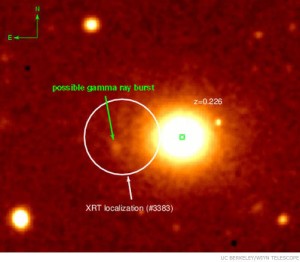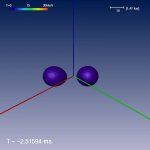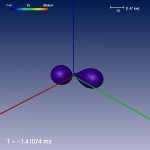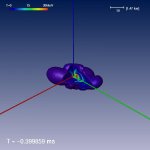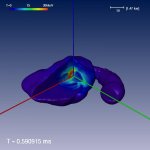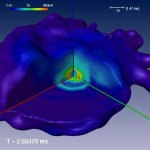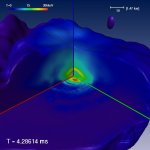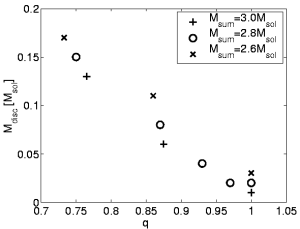|
|  |
Gamma-Ray bursts (GRBs) are bright and very energetic flashes of gamma
radiation with durations between some thousandths of a second and many
minutes. According to their duration, the roughly 3000 bursts detected
so far are divided into two classes. The so-called long bursts emit
gamma radiation for more than two seconds, whereas the short bursts
last less than two seconds. While the long bursts are relatively well
investigated and some of them could be linked to the explosive death
of massive stars, the origin of the short bursts has remained
enigmatic, because they are more challenging to observe. Their short
duration makes it difficult to catch the gamma radiation and to
determine their position on the sky sufficiently accurately to look
for "afterglow" signals in X-rays or optical light and thus to measure
their cosmological redshift and distance from the earth. Only recently
such precise localizations have been achieved in a few cases by the
 HETE satellite and the HETE satellite and the
 Swift
Gamma-Ray Burst Explorer. The bursts are hosted by elliptical
galaxies between two and six billion light years away and seem to come
from an old population of stellar objects, in agreement with the
hypothesis that they might be produced by merger events of binary
neutron stars (Figure 1). Swift
Gamma-Ray Burst Explorer. The bursts are hosted by elliptical
galaxies between two and six billion light years away and seem to come
from an old population of stellar objects, in agreement with the
hypothesis that they might be produced by merger events of binary
neutron stars (Figure 1).
Neutron stars are the extremely compact remnants which are left
behind when massive stars explode as supernovae at the end of their
lives. In a neutron star more than a solar mass of matter is
compressed into a sphere of roughly 20 kilometers diameter. The
density in a neutron star is therefore higher than that in
atomic nuclei. Sometimes such neutron
stars are born in binary systems and orbit around each other with
periods of less than one day. The most famous example is the
binary pulsar PSR 1913+16, whose discovery was rewared with the
Nobel Prize in Physics to Russell A. Hulse and Joseph H. Taylor in
1993. This discovery was spectacular because it confirmed a
prediction from Einstein's Theory of Gravity: Such compact
binary systems cannot live forever, but their orbital distance
shrinks continuously by the emission of gravitational waves.
Unavoidably, the two stars get closer and closer, swirling more
and more rapidly around each other, reaching velocities close to
the speed of light. Finally, they crash violently into
each other and get destroyed. What then happens is still a matter
of intense research and requires complex computer simulations which
solve the equations of Einstein's Theory of General Relativity.
Researchers at the Max-Planck Institute for Astrophysics have
developed such computer models which allow them to study these
events with more realism than before. The relativistic simulations
in particular include a detailed description of the properties of
dense and hot neutron star matter. They reveal that the
two colliding neutron stars merge into one very compact, rapidly
spinning object, in which temperatures of several hundred billion
degrees are reached (Figure 2). The core of this object is going
to collapse to a black hole within only fractions of a second,
leaving behind some matter in a
toroidal gas cloud that girds the equator of the spinning black hole.
Fictitious centrifugal forces like the ones experienced on a
merry-go-round, prevent this doughnut-shaped gas torus from being
immediately pulled into the black hole by its enormous gravity.
But friction will decelerate the gas motion
and will unavoidably drive the gas closer to the
black hole like swirling water to the sink. Spiralling inward to
the black hole, the gas heats up and can release huge amounts of
gravitational binding energy.
The energy output increases with the mass that is accumulated
in the gas torus and then swallowed by the black hole after many
revolutions.
Determining the amount of matter that can achieve escaping the
immediate collapse into the black hole was one of the main goals
of the computer simulations. The models of the astrophysicists
reveal that, depending on the ratio of the two neutron star masses
and the total system mass, the black hole is initially girded by
a few hundredths to more than a tenth of a solar mass of gas
(Figure 3), which is well sufficient to explain the energy output
of the short gamma-ray bursts whose distances could recently be
determined. The simulations therefore clearly support the possibility
that these gamma-ray bursts were the death throes of colliding binary
neutron stars, a long-standing hypothesis whose ultimate solidification
will require many more observations of well-localized short bursts
hand in hand with further theoretical exploration.
R. Oechslin, H.-Th. Janka
Literature:
R. Oechslin, H.-Th. Janka, Torus Formation in Neutron Star Mergers,
submitted to MNRAS,  astro-ph/0507099 astro-ph/0507099
|
